Oil AUDI A8 2003 D3 / 2.G Technical Features Manual
[x] Cancel search | Manufacturer: AUDI, Model Year: 2003, Model line: A8, Model: AUDI A8 2003 D3 / 2.GPages: 96, PDF Size: 5.51 MB
Page 16 of 96
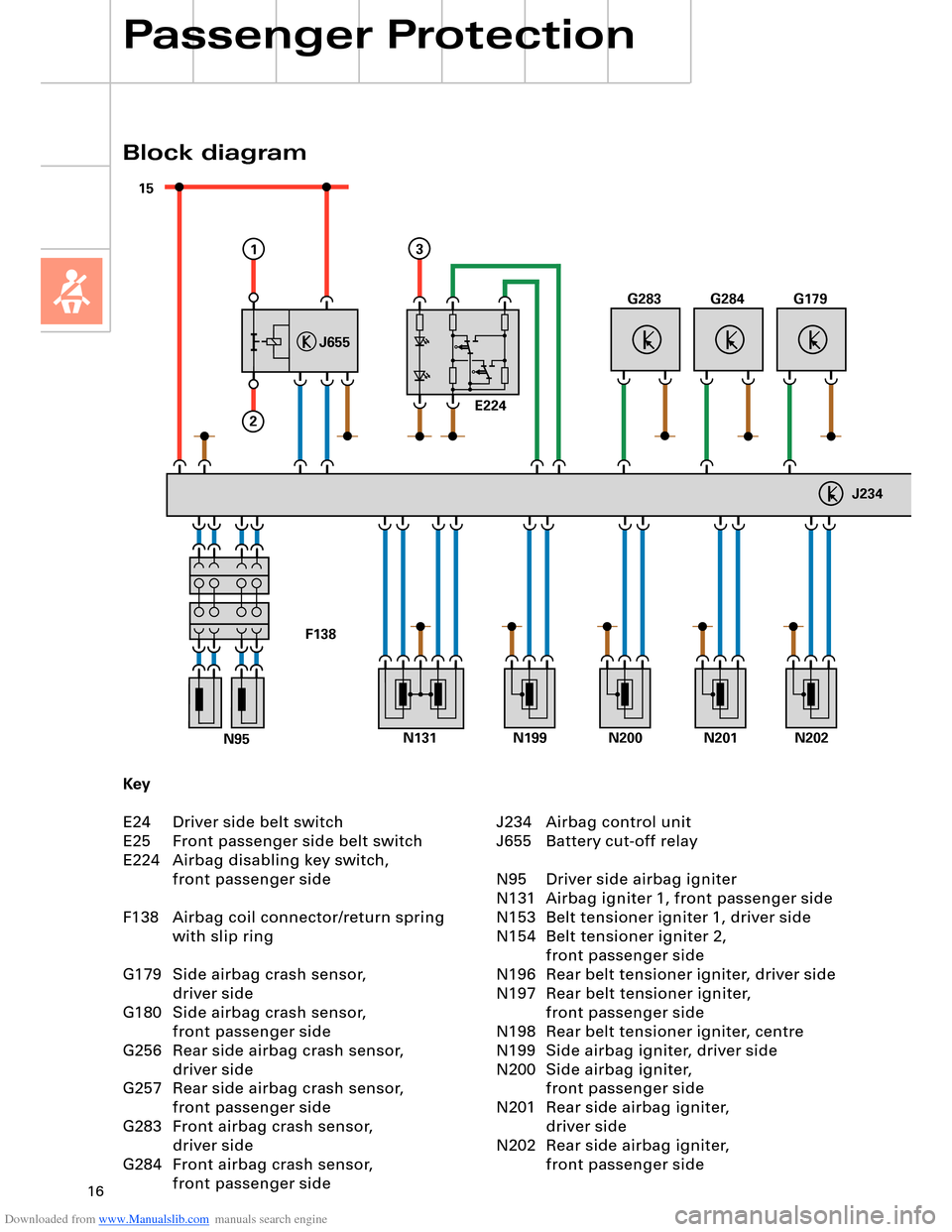
Downloaded from www.Manualslib.com manuals search engine 16
15
J234
J655
1
2
E224
3
G283G284G179
N131
F138
N202N199N200N201N95
Key
E24 Driver side belt switch
E25 Front passenger side belt switch
E224 Airbag disabling key switch,
front passenger side
F138 Airbag coil connector/return spring
with slip ring
G179 Side airbag crash sensor,
driver side
G180 Side airbag crash sensor,
front passenger side
G256 Rear side airbag crash sensor,
driver side
G257 Rear side airbag crash sensor,
front passenger side
G283 Front airbag crash sensor,
driver side
G284 Front airbag crash sensor,
front passenger side
Block diagram
Passenger Protection
J234 Airbag control unit
J655 Battery cut-off relay
N95 Driver side airbag igniter
N131 Airbag igniter 1, front passenger side
N153 Belt tensioner igniter 1, driver side
N154 Belt tensioner igniter 2,
front passenger side
N196 Rear belt tensioner igniter, driver side
N197 Rear belt tensioner igniter,
front passenger side
N198 Rear belt tensioner igniter, centre
N199 Side airbag igniter, driver side
N200 Side airbag igniter,
front passenger side
N201 Rear side airbag igniter,
driver side
N202 Rear side airbag igniter,
front passenger side
Page 23 of 96
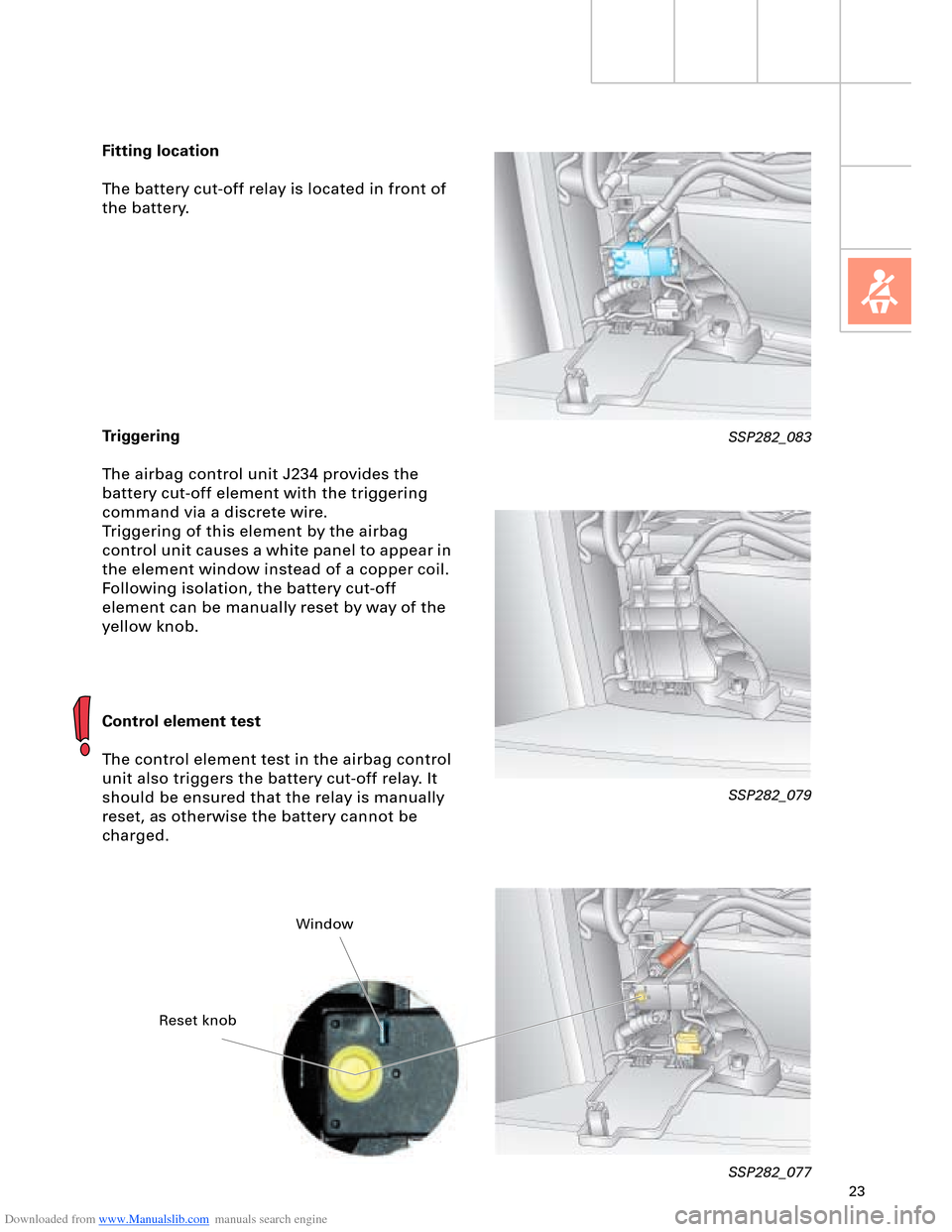
Downloaded from www.Manualslib.com manuals search engine 23
Fitting location
The battery cut-off relay is located in front of
the battery.
Triggering
The airbag control unit J234 provides the
battery cut-off element with the triggering
command via a discrete wire.
Triggering of this element by the airbag
control unit causes a white panel to appear in
the element window instead of a copper coil.
Following isolation, the battery cut-off
element can be manually reset by way of the
yellow knob.
Control element test
The control element test in the airbag control
unit also triggers the battery cut-off relay. It
should be ensured that the relay is manually
reset, as otherwise the battery cannot be
charged.
SSP282_079
SSP282_077
SSP282_083
Reset knobWindow
Page 24 of 96
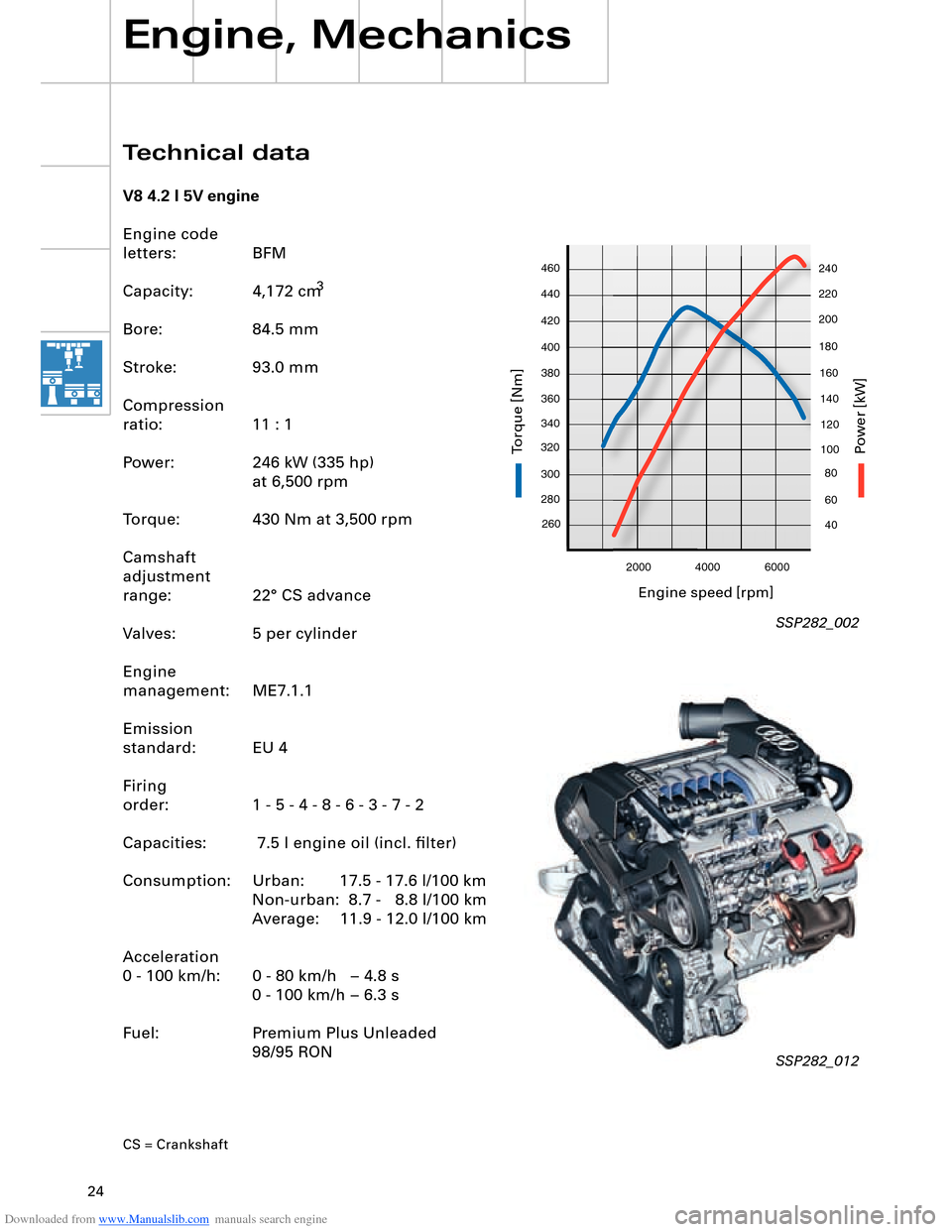
Downloaded from www.Manualslib.com manuals search engine 24
Engine, Mechanics
200040006000
40
60
80
100
120
140
160
180
200
220
240
260
280 300
320
340 360380 400
420 440
460
Technical data
V8 4.2 l 5V engine
Engine code
letters: BFM
Capacity:
3
Bore: 84.5 mm
Stroke: 93.0 mm
Compression
ratio: 11 : 1
Power: 246 kW (335 hp)
at 6,500 rpm
Torque: 430 Nm at 3,500 rpm
Camshaft
adjustment
range: 22° CS advance
Valves: 5 per cylinder
Engine
management: ME7.1.1
Emission
standard: EU 4
Firing
order: 1 - 5 - 4 - 8 - 6 - 3 - 7 - 2
Capacities: 7.5 l engine oil (incl. filter)
Consumption: Urban: 17.5 - 17.6 l/100 km Non-urban: 8.7 - 8.8 l/100 km
Average: 11.9 - 12.0 l/100 km
Acceleration
0 - 100 km/h: 0 - 80 km/h – 4.8 s 0 - 100 km/h – 6.3 s
Fuel: Premium Plus Unleaded 98/95 RON
CS = Crankshaft
SSP282_002
SSP282_012
Engine speed [rpm]
P
ower [kW]
T
orq ue [Nm]
4,172 cm
Page 25 of 96

Downloaded from www.Manualslib.com manuals search engine 25
200040006000
260
280 300
320
340 360380 400
420 440
46040
60
80
100
120
140
160
180
200
220
240
V8 3.7 l 5V engine
Engine code
letters: BFL
Capacity:
3
Bore: 84.5 mm
Stroke: 82.4 mm
Compression
ratio: 11 : 1
Power: 206 kW (280 hp)
at 6,000 rpm
Torque: 360 Nm at 3,750 rpm
Camshaft
adjustment
range: 13° CS advance
Valves: 5 per cylinder
Engine
management: ME7.1.1
Emission
standard: EU 4
Firing
order: 1 - 5 - 4 - 8 - 6 - 3 - 7 - 2
Capacities: 7.5 l engine oil (incl. filter)
Consumption: Urban: 17.1 - 17.3 l/100 km Non-urban: 8.6 - 8.8 l/100 km
Average: 11.7 - 11.9 l/100 km
Acceleration
0 - 100 km/h: 0 - 80 km/h – 5.6 s 0 - 100 km/h – 7.3 s
Fuel: Premium Plus Unleaded 98/95 RON
SSP282_001
SSP282_011
Engine speed [rpm]
P
ower [kW]
T
orq ue [Nm]
3,697 cm
Page 30 of 96
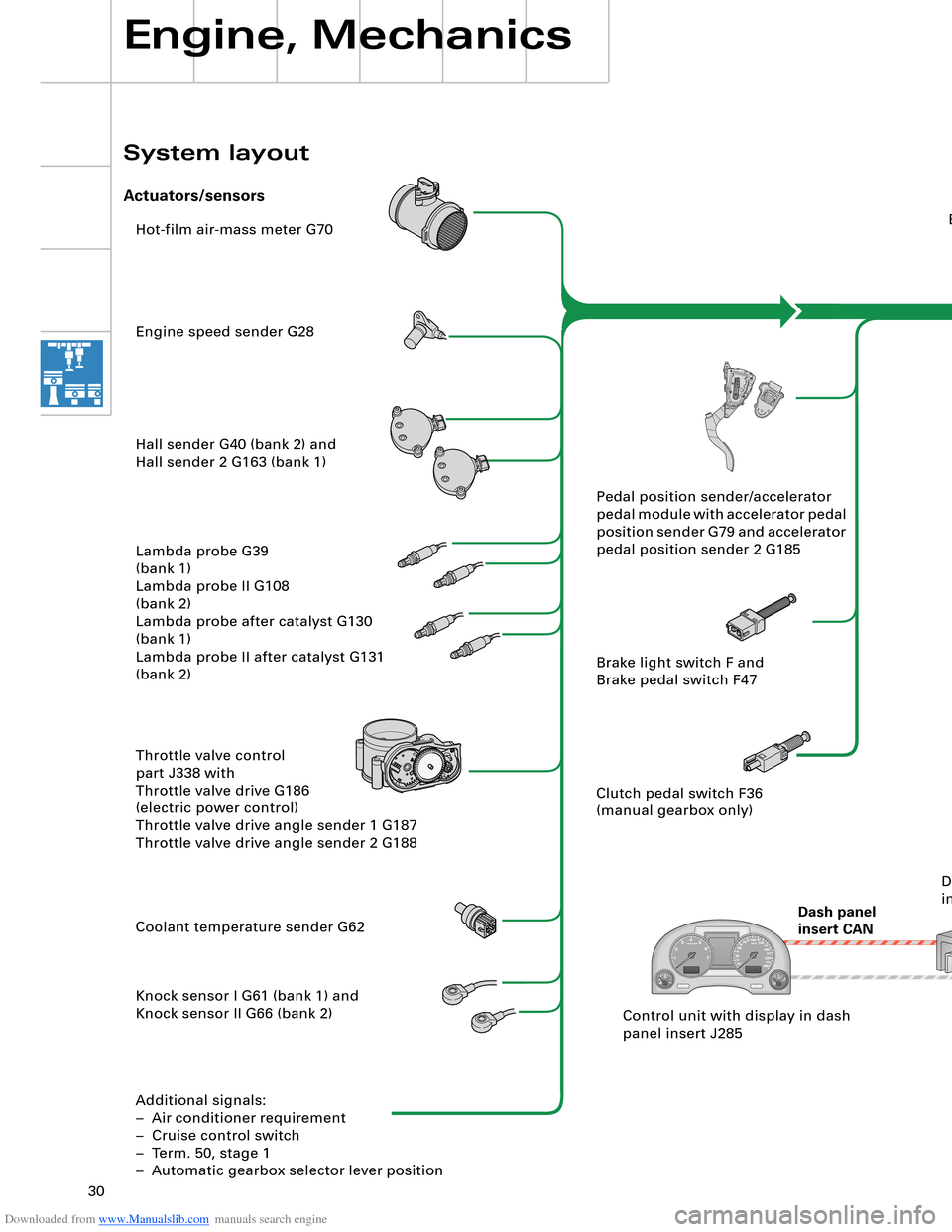
Downloaded from www.Manualslib.com manuals search engine 30
Hot-film air-mass meter G70
Engine speed sender G28
Hall sender G40 (bank 2) and
Hall sender 2 G163 (bank 1)
Lambda probe G39
(bank 1)
Lambda probe II G108
(bank 2)
Lambda probe after catalyst G130
(bank 1)
Lambda probe II after catalyst G131
(bank 2)
Throttle valve control
part J338 with
Throttle valve drive G186
(electric power control)
Throttle valve drive angle sender 1 G187
Throttle valve drive angle sender 2 G188
Coolant temperature sender G62
Knock sensor I G61 (bank 1) and
Knock sensor II G66 (bank 2)
Additional signals:
– Air conditioner requirement
– Cruise control switch
– Term. 50, stage 1
– Automatic gearbox selector lever positionEngine control unit J623
Steering
angle sender G85
ESP
control unit J104
Dash panel
insert CANAutomatic
gearbox
control unit J217
Airbag
control unit J234Intake manifold changeover valve
N156 and
Intake manifold changeover valve 2
N261
Left electrohydraulic engine mounting
solenoid valve N144 and
Right electrohydraulic engine mounting
solenoid valve N145
Torque rod valve N382
Lambda probe heater Z19
(bank 1) and
Lambda probe 2 heater Z28
(bank 2)
Lambda probe 1 heater
after catalyst Z29
Lambda probe 2 heater
after catalyst Z30
Additional signals:
– Starter relay term. 50, stage 2
– Tank leakage pump (USA only)
– Air conditioner compressor (out)Fuel pump relay J17
Fuel pump G6
Fuel pump II relay J49
Fuel pump G23
Injectors N30, N31, N32, N33 (bank 1)
Injectors N83, N84, N85, N86 (bank 2)
Ignition coils N (no. 1 cyl.), N128 (no. 2 cyl.),
N158 (no. 3 cyl.), N163 (no. 4 cyl.)
Ignition coils N164 (no. 5 cyl.), N189 (no. 6 cyl.),
N190 (no. 7 cyl.), N191 (no. 8 cyl.)
Activated charcoal filter system solenoid
valve 1 N80
Secondary-air pump relay J299 and
Secondary-air pump motor V101
Secondary air inlet valve N112
Throttle valve control part J338
With throttle valve drive G186
Inlet camshaft timing adjustment valve 1
N205 (bank 1)
and
N208 (bank 2) Pedal position sender/accelerator
pedal module with accelerator pedal
position sender G79 and accelerator
pedal position sender 2 G185
Brake light switch F and
Brake pedal switch F47
Clutch pedal switch F36
(manual gearbox only)
Control unit with display in dash
panel insert J285Data bus diagnostic
interface J533
Engine, Mechanics
System layout
Actuators/sensors
SSP282_091 Drive system CAN
Diagnosis CAN
Page 31 of 96
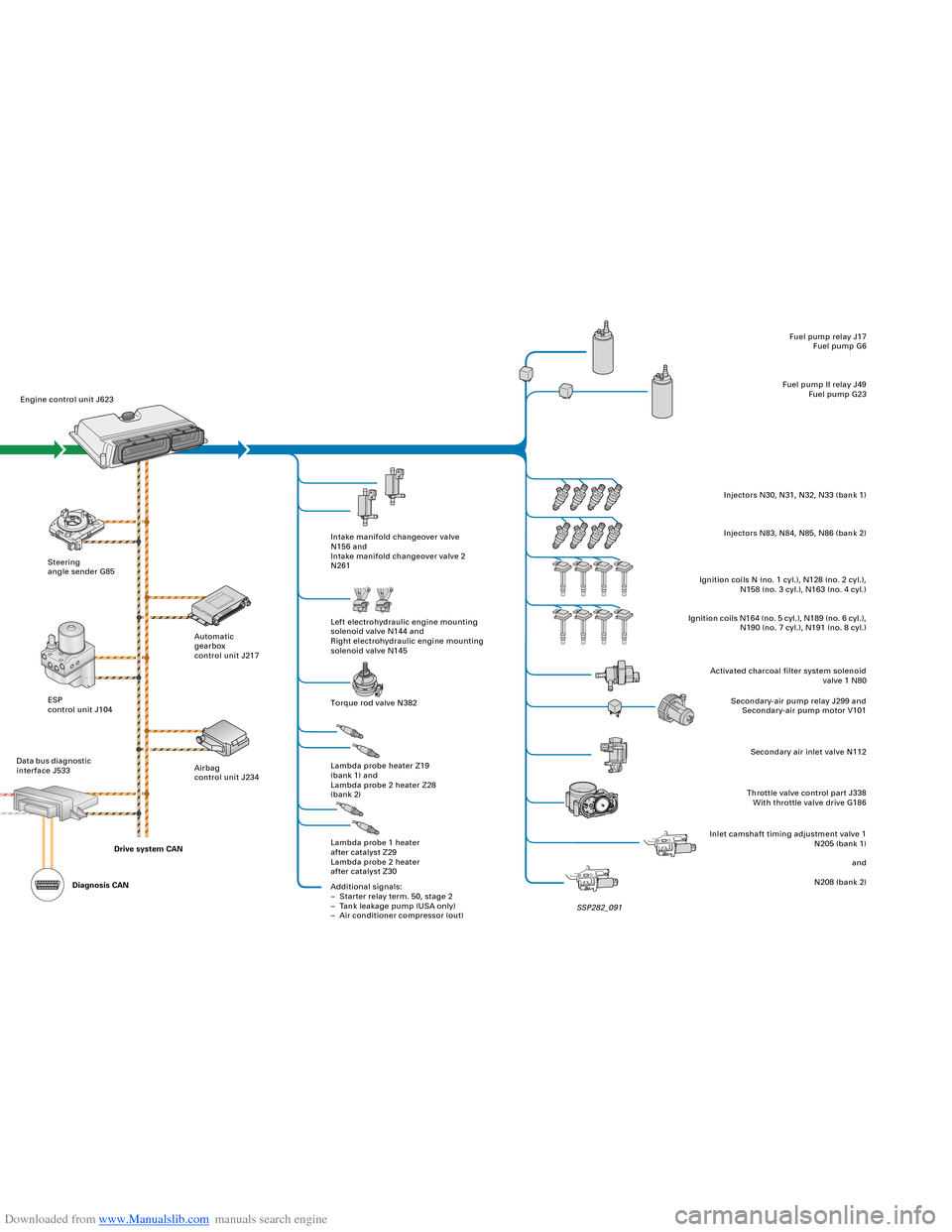
Downloaded from www.Manualslib.com manuals search engine 30
Hot-film air-mass meter G70
Engine speed sender G28
Hall sender G40 (bank 2) and
Hall sender 2 G163 (bank 1)
Lambda probe G39
(bank 1)
Lambda probe II G108
(bank 2)
Lambda probe after catalyst G130
(bank 1)
Lambda probe II after catalyst G131
(bank 2)
Throttle valve control
part J338 with
Throttle valve drive G186
(electric power control)
Throttle valve drive angle sender 1 G187
Throttle valve drive angle sender 2 G188
Coolant temperature sender G62
Knock sensor I G61 (bank 1) and
Knock sensor II G66 (bank 2)
Additional signals:
– Air conditioner requirement
– Cruise control switch
– Term. 50, stage 1
– Automatic gearbox selector lever positionEngine control unit J623
Steering
angle sender G85
ESP
control unit J104
Dash panel
insert CANAutomatic
gearbox
control unit J217
Airbag
control unit J234Intake manifold changeover valve
N156 and
Intake manifold changeover valve 2
N261
Left electrohydraulic engine mounting
solenoid valve N144 and
Right electrohydraulic engine mounting
solenoid valve N145
Torque rod valve N382
Lambda probe heater Z19
(bank 1) and
Lambda probe 2 heater Z28
(bank 2)
Lambda probe 1 heater
after catalyst Z29
Lambda probe 2 heater
after catalyst Z30
Additional signals:
– Starter relay term. 50, stage 2
– Tank leakage pump (USA only)
– Air conditioner compressor (out)Fuel pump relay J17
Fuel pump G6
Fuel pump II relay J49
Fuel pump G23
Injectors N30, N31, N32, N33 (bank 1)
Injectors N83, N84, N85, N86 (bank 2)
Ignition coils N (no. 1 cyl.), N128 (no. 2 cyl.),
N158 (no. 3 cyl.), N163 (no. 4 cyl.)
Ignition coils N164 (no. 5 cyl.), N189 (no. 6 cyl.),
N190 (no. 7 cyl.), N191 (no. 8 cyl.)
Activated charcoal filter system solenoid
valve 1 N80
Secondary-air pump relay J299 and
Secondary-air pump motor V101
Secondary air inlet valve N112
Throttle valve control part J338
With throttle valve drive G186
Inlet camshaft timing adjustment valve 1
N205 (bank 1)
and
N208 (bank 2) Pedal position sender/accelerator
pedal module with accelerator pedal
position sender G79 and accelerator
pedal position sender 2 G185
Brake light switch F and
Brake pedal switch F47
Clutch pedal switch F36
(manual gearbox only)
Control unit with display in dash
panel insert J285Data bus diagnostic
interface J533
Engine, Mechanics
System layout
Actuators/sensors
SSP282_091 Drive system CAN
Diagnosis CAN
Page 39 of 96
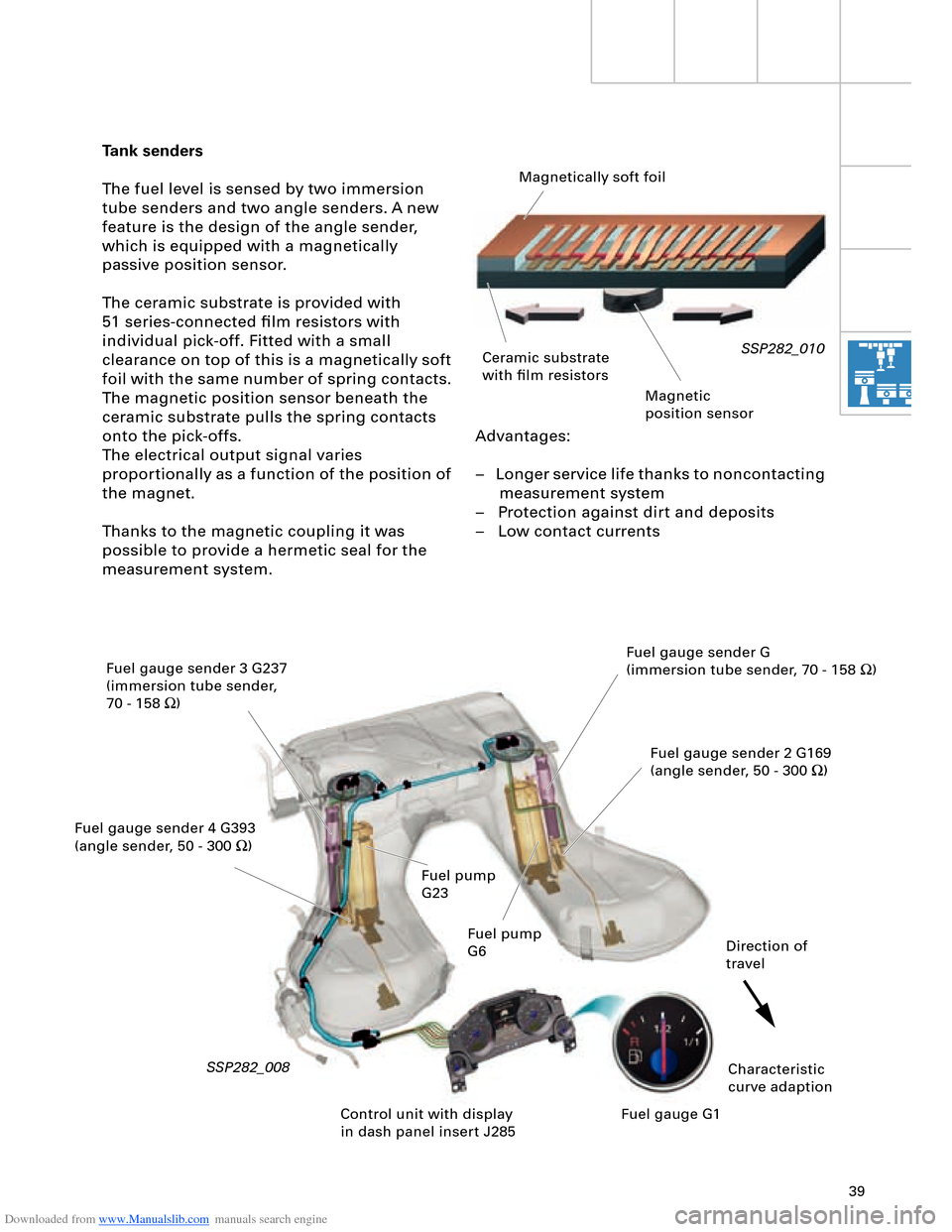
Downloaded from www.Manualslib.com manuals search engine 39
Advantages:
– Longer service life thanks to noncontacting
measurement system
– Protection against dirt and deposits
– Low contact currents
Tank senders
The fuel level is sensed by two immersion
tube senders and two angle senders. A new
feature is the design of the angle sender,
which is equipped with a magnetically
passive position sensor.
The ceramic substrate is provided with
51 series-connected film resistors with
individual pick-off. Fitted with a small
clearance on top of this is a magnetically soft
foil with the same number of spring contacts.
The magnetic position sensor beneath the
ceramic substrate pulls the spring contacts
onto the pick-offs.
The electrical output signal varies
proportionally as a function of the position of
the magnet.
Thanks to the magnetic coupling it was
possible to provide a hermetic seal for the
measurement system.
SSP282_010
SSP282_008
Magnetically soft foil
Ceramic substrate
with film resistors
Magnetic
position sensor
Fuel gauge sender 3 G237
(immersion tube sender,
70 - 158 W)
Fuel gauge sender 4 G393
(angle sender, 50 - 300 W)Fuel gauge sender G
(immersion tube sender, 70 - 158 W)
Fuel gauge sender 2 G169
(angle sender, 50 - 300 W)
Characteristic
curve adaption Direction of
travel
Control unit with display
in dash panel insert J285Fuel gauge G1 Fuel pump
G23
Fuel pump
G6
Page 45 of 96
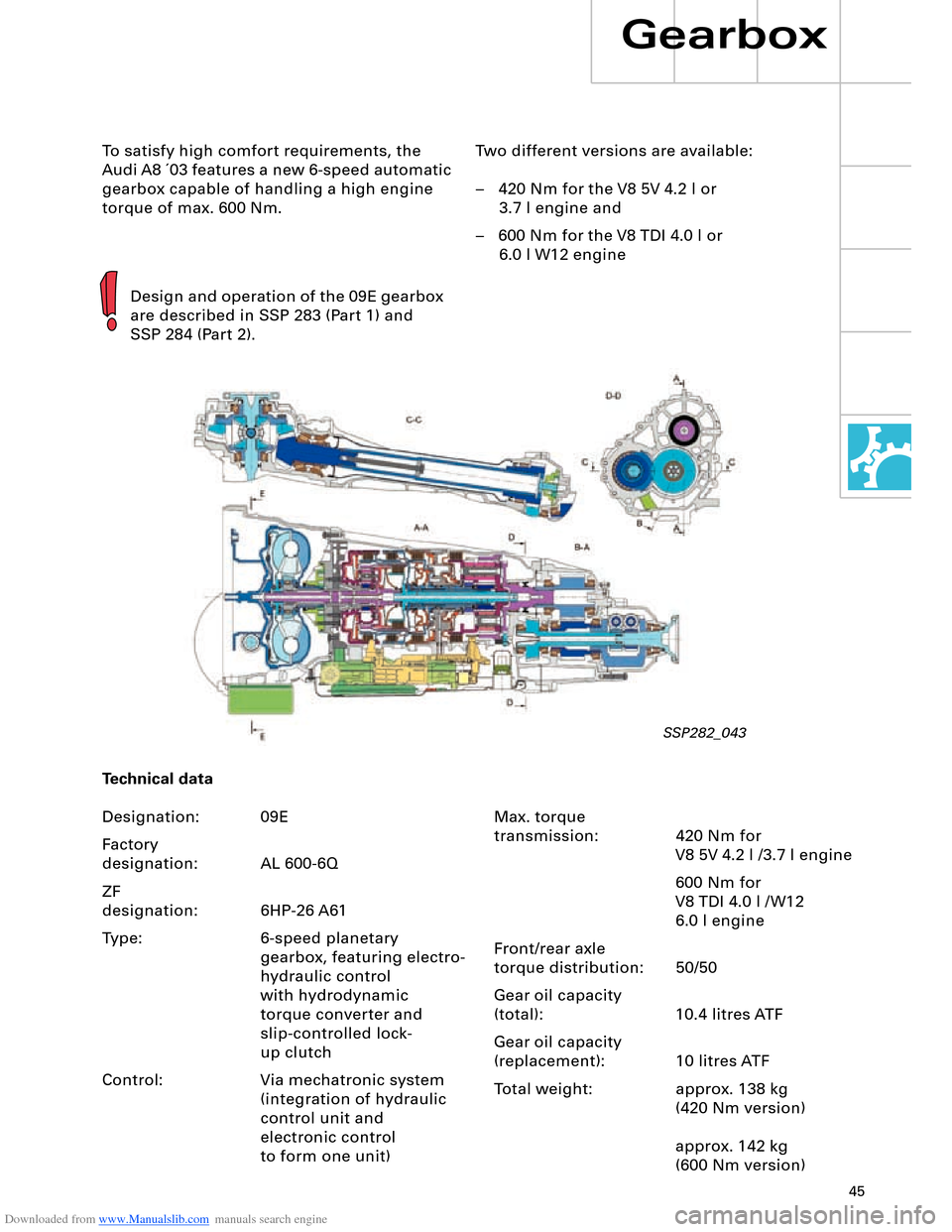
Downloaded from www.Manualslib.com manuals search engine 45
Two different versions are available:
– 420 Nm for the V8 5V 4.2 l or
3.7 l engine and
– 600 Nm for the V8 TDI 4.0 l or
6.0 l W12 engine To satisfy high comfort requirements, the
Audi A8 ´03 features a new 6-speed automatic
gearbox capable of handling a high engine
torque of max. 600 Nm.
Gearbox
Design and operation of the 09E gearbox
are described in SSP 283 (Part 1) and
SSP 284 (Part 2).
SSP282_043
Technical data
Designation: 09E
Factory
designation: AL 600-6Q
ZF
designation: 6HP-26 A61
Type: 6-speed planetary
gearbox, featuring electro-
hydraulic control
with hydrodynamic
torque converter and
slip-controlled lock-
up clutch
Control: Via mechatronic system
(integration of hydraulic
control unit and
electronic control
to form one unit)Max. torque
transmission: 420 Nm for
V8 5V 4.2 l /3.7 l engine
600 Nm for
V8 TDI 4.0 l /W12
6.0 l engine
Front/rear axle
torque distribution: 50/50
Gear oil capacity
(total): 10.4 litres ATF
Gear oil capacity
(replacement): 10 litres ATF
Total weight: approx. 138 kg
(420 Nm version)
approx. 142 kg
(600 Nm version)
Page 46 of 96
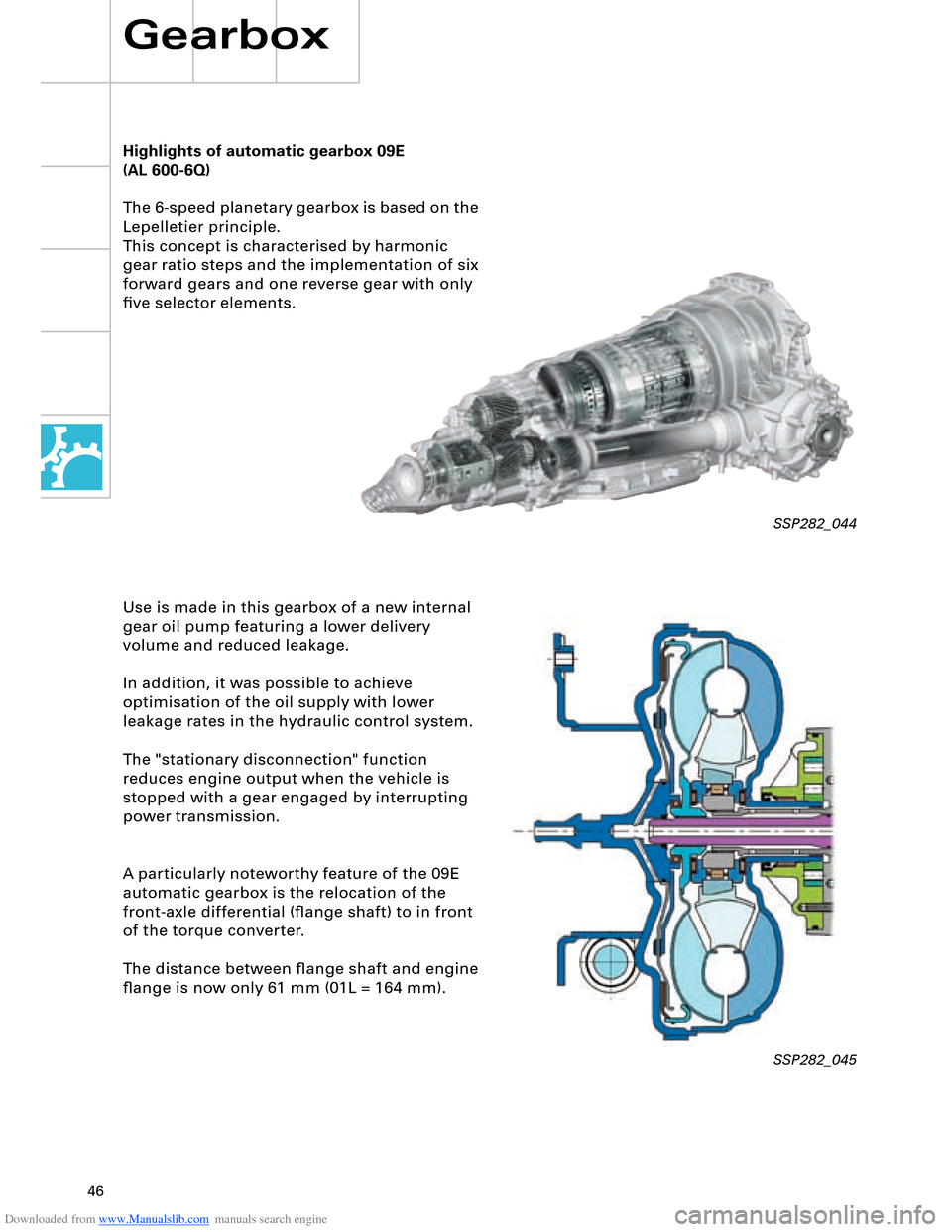
Downloaded from www.Manualslib.com manuals search engine 46
Highlights of automatic gearbox 09E
The 6-speed planetary gearbox is based on the
Lepelletier principle.
This concept is characterised by harmonic
gear ratio steps and the implementation of six
forward gears and one reverse gear with only
five selector elements.
Use is made in this gearbox of a new internal
gear oil pump featuring a lower delivery
volume and reduced leakage.
In addition, it was possible to achieve
optimisation of the oil supply with lower
leakage rates in the hydraulic control system.
The "stationary disconnection" function
reduces engine output when the vehicle is
stopped with a gear engaged by interrupting
power transmission.
A particularly noteworthy feature of the 09E
automatic gearbox is the relocation of the
front-axle differential (flange shaft) to in front
of the torque converter.
The distance between flange shaft and engine
flange is now only 61 mm (01L = 164 mm).
Gearbox
SSP282_044
SSP282_045
(AL 600-6Q)
Page 73 of 96

Downloaded from www.Manualslib.com manuals search engine 7374
A distinction is made between two air
conditioner unit versions
– 2-zone front and rear climate
control
– 4-zone front and rear climate
control
and three types of control and
display unit
– Air conditioner control panel with
no seat heating/ventilation
– Air conditioner control panel with
seat heating
– Air conditioner control panel with
seat heating and seat ventilation
(identified by part number index).
SSP282_099
Self-diagnosis
Fault diagnosis and measured value blocks
for air conditioner and seat heating system
can be read out by way of address words 08
"Air conditioner/heater electronics" and 28
"Rear climate control". The functions of and
exact procedure for self-diagnosis and
assisted fault-finding with VAS 5051 can be
found in the Heating/Air Conditioner
Workshop Manual for the relevant vehicle
model.
Operating principle
When the ignition is switched on, the
Climatronic control unit J255 starts up with
the same temperature, air distribution and
fresh-air blower speed settings etc. as were
applicable the last time the ignition was
switched off by way of the appropriate key or
using fingerprint recognition.
If fingerprint recognition has been
implemented, this has priority over key
recognition (refer also to SSP 287 – Audi A8 ´03
Electrical Components).
Personalised settings
The following settings can be made for each
climate control zone (front left, right and,
optionally, with 4-zone climate control rear left
and right):
– Left/right temperature
– Air flow
– Left/right air distribution
– Left/right seat heating
– Left/right seat ventilation
– Operating modes (AUTO for driver and front
passenger, temperature-adjustable centre
vents, automatically controlled
recirculated-air mode, ECON)
The heated windscreen can be activated by
way of the air conditioner defrost button or
the air conditioner control unit automatically
switches on the electric heated windscreen if
the appropriate conditions are satisfied
(windscreen defrost or automatic mode on
cold starting).
The Climatronic J255 and heated windscreen
J505 control units communicate by way of the
LIN bus. The Climatronic control unit transmits
the specified windscreen heating power to the
heated windscreen control unit on the LIN bus.
Heating/Air Conditioner
Key recognition takes place in the case of
remote control (radio or key transponder),
with the driver identification control unit
providing the Climatronic control unit J255
with the appropriate information by way of
the CAN bus.
The electrically heated windscreen is only
supplied with the amount of power which can
currently be drawn from the electrical system
without draining the battery. This is
monitored by the energy management
control unit J644.
As is the case with the Audi A4, the
windscreen is heated by applying voltage to a
metallic foil fitted in the glass (refer to
SSP 213).
As in the Audi A4, the air conditioner
compressor is regulated as a function of load
and controlled externally by way of the
compressor regulating valve (refer to
SSP 240). The Climatronic control unit J255 is
connected to the convenience CAN, via
which diagnosis is also performed.
A manual air conditioning system is not
available.